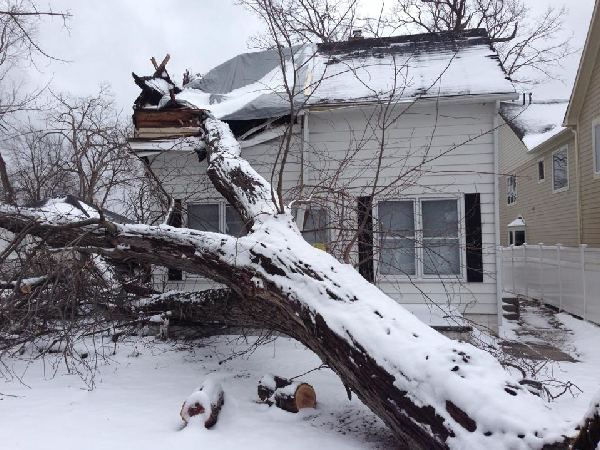In the aftermath of severe weather events like lightning strikes, windstorms, and heavy snowfall, trees often bear the brunt of nature’s fury. As a property owner, it’s crucial to understand how to address the aftermath effectively to ensure safety and preserve the beauty of your landscape.
After a bout of severe weather, the first step is to assess the extent of damage to your trees and surrounding landscape. The severity of the damage can vary depending on the type and intensity of the weather event.
Lightning strikes can cause significant harm to trees, including trunk damage, bark stripping, and even complete tree loss.
High winds during storms can lead to uprooted trees, broken branches, and leaning trunks.
The weight of heavy snow accumulation can cause branches to bend or break, leading to structural damage.Thankfully, winter is a great time for tree care.
Safety should always be the top priority when dealing with storm-damaged trees.
Identify any immediate hazards, such as hanging branches or leaning trees, that pose a risk to people or property. Cordoning off the affected area prevents accidents and ensures the safety of bystanders. For extensive damage or hazardous situations, enlist the help of certified arborists or tree care professionals.
In some cases, damaged trees may need to be removed entirely, while others can be salvaged through restoration efforts. Irreparable damage or safety concerns may necessitate the removal of severely damaged trees. Professional arborists can safely remove trees and debris. For trees with potential for recovery, restoration techniques such as pruning, bracing, or cabling can help restore structural integrity and promote healthy growth.




How can I tell if my tree is beyond repair?
If more than 50% of the tree’s canopy is damaged or if the trunk shows signs of structural instability, it may be irreparable.
Is it safe to attempt tree pruning on my own?
For safety reasons and optimal results, it’s recommended to hire trained professionals for tree pruning, especially after severe weather events.
Can damaged trees pose a risk of falling later?
Yes, storm-damaged trees are often weakened and can pose a risk of falling, especially during subsequent storms or high winds.
What should I do if a tree falls on my property during a storm?
Ensure everyone is safe, then assess the damage and contact tree removal professionals if necessary. Avoid attempting to remove the tree yourself.
How long does it take for storm-damaged trees to recover?
The recovery time depends on various factors such as the extent of damage, tree species, and environmental conditions. It can range from several months to several years.
Navigating tree services after severe weather, including lightning strikes, windstorms, and heavy snow, requires a combination of caution, expertise, and proactive measures. Follow these tips to mitigate future risks and ensure the safety and beauty of your landscape for years to come.
tree care, pest, lawn, tree, international society of arboriculture, risk, pest control, health, arborist, soil, disease, mulch, pruning, shrub, property, root, landscape, arboriculture, insect, certified arborist, fertilizer, urban forestry, tree planting, wood, forestry, bark, tree service, lawn care, tree company, tree maintenance, tree care company, tree care professional, safety, risk assessment, trunk, south carolina, wind, injury, north carolina, personal protective equipment, species, oregon, all rights reserved, hazard, customer, snow, oak, nutrient, zip code, construction, privacy policy, arbor day, pesticide, drought, new jersey, arbor day foundation, knowledge, sustainability, utah, kentucky, idaho, wound, health care, attention, new hampshire, agriculture, soil compaction, certification, maple, arboretum, beauty, rhode island, maryland, logging, price, firewood, tree companies, tree service company, general, removal company, tree service companies, tree experts, vegetation, lumber, infrastructure, massachusetts, cash, organization, louisiana, arkansas, kansas, mississippi, debris, oklahoma, new mexico, west virginia, pine, south dakota, connecticut, wisconsin, north dakota, chainsaw, contract, missouri, emergency, tree services, tcia, hire, bartlett tree, lewis, tree removal, tree removal companies, certified arborists, liability, tree care companies, removal services, arborists, tree removed, companies, tree removal cost, tree removal services, cleaning, ecosia org, email address, yard, iowa, nebraska, wyoming, the bronx, brooklyn, staten island, queens, new york city, tree stump, expert, arborist near me, tree doctor near me, tree trimming service, bathroom, roof, driveway, emergency service, carpet, leaf, wall, customer satisfaction, oklahoma city, dallas, lightning, minneapolis, basement, concrete, horticulture, long island, disease management, floor, tree trimming near me, tree cutting service, tree cutting service near me, stump grinding near me, tree surgeon near me, tree trimming service near me, stump removal near me, tree removal service near me, tree removal near me, tree stump removal, tree trimming, stump removal, tree removal service, stump grinding, land clearing